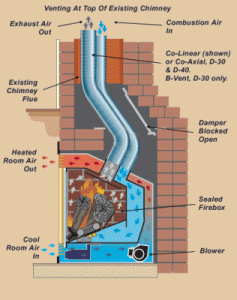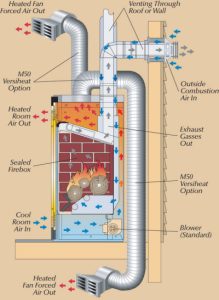Check this article complete here
By Mendota
Direct Vent
Direct vent fireplaces draw combustion air from the outdoors and exhaust their combustion products to the outdoors—eliminating the need for a chimney. The combustion system should be sealed from the living area to assure high air quality, maximum efficiency and trouble-free operation in today’s tightly insulated homes.
Mendota’s sealed combustion, direct vent system draws air for combustion from outside the home into a sealed firebox. Exhaust is expelled through a separate vent. Room air is heated and recirculated. The system keeps warm air in and cold air out.
Heat Management

Mendota’s exclusive Versiheat technology moves heat from your fireplace to other areas in your home. Mendota fireplaces have connections for two Versiheat kits to allow the transfer of heat to two other areas. Heat is moved through ducts with their own blowers and thermostats. This optional system provides heat to more than one room and moves unwanted heat out of the fireplace.
Mendota’s Heat Transfer System allows you to not only direct the heat from your Mendota fireplace to other areas of your home, but also to direct undesired heat out of your home completely. Up to two Heat Transfer System kits can be installed in specific Mendota fireplaces and each kit can extract up to 95% of the heat generated by the fireplace and transfer it through ducts to the desired location.
Vent-Free
Another industry option is vent-free, ventless or unvented gas fireplaces. This kind of fireplace is designed to draw and expel combustion gasses and moisture directly into the room. While some manufacturers claim that vent-free fireplaces burn hot enough for complete fuel combustion, we’ve found that carbon monoxide gasses can still linger in your living area. At Mendota, we do not manufacture this type of gas fireplace. In fact, fireplaces and stoves without proper ventilation are illegal in many states and municipalities.


